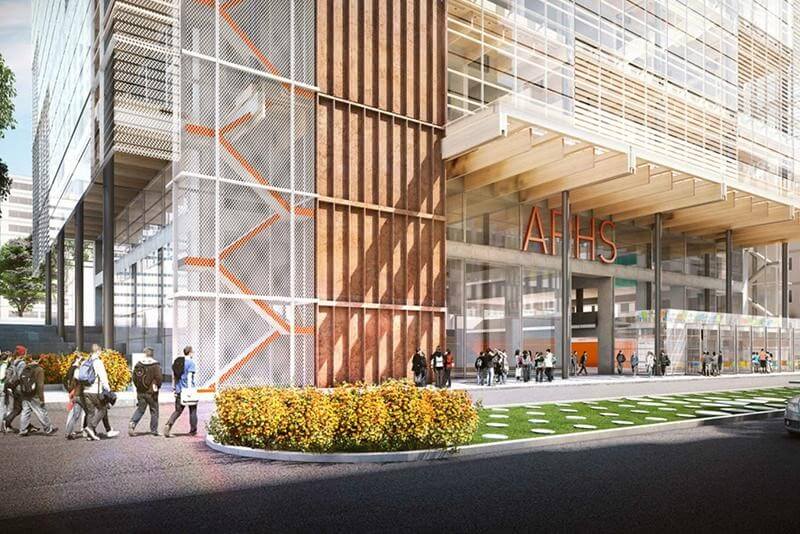Vertical schools are on the rise in Australia and Safetyline Jalousie was involved with one of the pioneers in this space.
There is a definite trend towards the development of vertical schools in Australia. This trend mirrors what we’re seeing in the cities in regards to high-rise buildings. With more people and limited space, developers have to seek other options.
Vertical schools solve the space problem. Instead of a sprawling campus, you get a self-contained building. This building still offers everything that students need and allows for further development around the school building.
In fact, vertical schools can offer more space than their horizontal counterparts. This confronts the issue of crowded classrooms. Larger classrooms can lead to better learning outcomes. Plus, they allow for more facilities, such as gyms and libraries.
It seems that vertical schools will become more common as time goes on.
Safetyline Jalousie was recently involved with one of the pioneers in this space, Arthur Phillip High School. Here’s what you need to know about the project and what you can learn from it.
Arthur Phillip High School – A Case Study
Arthur Phillip High School was not a new school when it adopted the vertical ideology. In fact, the school had taught students for several decades before its redesign.
It is however, the first of its kind for the NSW Government and is a landmark education project for the state. Located in the heart of Parramatta, Arthur Phillip School will provide a variety of benefits to its students and the community.
But as the first of its kind in the state, the school had a lot of barriers to break through. One of these included the window selection and ensuring it confronted the safety concerns that come with high-rise buildings.
The Challenges
Safety is a key concern with all high-rise buildings and a particular issue in schools. With so many young children running around, it’s easy to envision something going wrong. Weak windows lead to a higher capacity for breakage. That increases the risk of falls from great heights as well as creating a shattered glass issue.
The project team for Arthur Phillip High School brought these challenges to Safetyline Jalousie. They needed safe and strong windows that could withstand the demands placed on them.
The windows also had several wind and water specifications that they needed to meet. Again, a common requirement in high-rise construction. Tall buildings have to account for more powerful winds plus, they have to withstand higher water resistance.
There was also a size issue to take into account. Many of the windows would need to be up to 3.9m tall and up to 1.4m wide. Most louvre windows can’t reach this size while maintaining compliance with wind and water regulations.
Then, there’s the natural ventilation issue.
Ventilation is key in the classroom. There are many studies that highlight the benefits of natural air to students. Chief among these is a reduction in absences due to illness. A Lawrence Berkeley National Laboratory study shows this. Researchers looked at 150 classrooms and they found that natural air led to a 3.4% reduction in illness-related absences.
The Safetyline Jalousie Solution
Safetyline Jalousie was the best choice for the school for several reasons.
First, there’s the natural ventilation issue. Louvres offer the largest free air area of any window type. Their use allowed for plenty of air to enter the building without compromising student safety.
Furthermore, Safetyline Jalousie offered the most flexible windows in regards to size. Without Safetyline Jalousie, the school would have had to use another window type or used multiple louvre banks where Safetyline Jalousie could use just one.
Safetyline Jalousie supplied large louvre windows that achieved the wind and water resistance needed. These windows were also installed at all levels of the building.
In addition to the performance specifications, Safetyline Jalousie Louvre windows also tackle the safety concerns associated with education projects, particularly in regards to balustrade compliance, fall prevention and impact resistance. The design of the windows ensures that there is no risk of falls, even when the windows are fully open. The same applies to the strength of the system. Safetyline Jalousie louvres have been impact tested to an incredible 550kg and being top pivoted with no exposed edges on the internal side, the risk of accidents and injury is further reduced.
The use of laminated glass guarded against the possibility of shattering. If one of the windows does break, it presents less of a threat to students because the glass is held together by its interlayer.
In the glass selection, thermal comfort was another critical element and is something that can affect student learning outcomes. Achieving the wrong comfort levels can distract both teachers and students. The use of Comfortplus glass in the Safetyline Jalousie louvre system assists in improving the insulation and solar control compared to ordinary glass.
The End Result
Safetyline Jalousie delivered approximately 2,000sqm of windows for this project. This makes Arthur Phillip High School the company’s largest single project to date.
Each louvre window meets the rigid wind, water and safety requirements that were key requisites in all aspects of the school’s design.
What Can You Learn?
This was an interesting project for Safetyline due to its ground-breaking nature. Arthur Phillip High School is an innovator in the vertical school space.
Here’s what you can learn from this project.
Lesson #1 – Student Safety is Paramount
Vertical schools can be large enough to incorporate students of every age. This means the windows used must allow for any eventuality.
The use of strong windows that can withstand impacts is a must, as is laminated safety glass. Forceful impacts and the risk of glass breakage must be considered in the design of any school project. Choosing window products like Safetyline Jalousie that meet or exceed these requirements lowers the risk of injury if an accident does occur.
The use of Safetyline Jalousie louvre windows also eliminates the risk of falls from high places. A fall from 17 floors up would prove lethal for anyone. Safetyline Jalousie louvre windows allow maximum ventilation without creating large open spaces.
On top of general student safety, you also have to consider performance. Any windows you use must be able to withstand the strong wind and water pressures felt at the top or edges of a high rise building.
Lesson #2 – Solve the Natural Ventilation Challenge
As mentioned above, natural ventilation offers several benefits to students.
The circulation of natural, fresh air creates a better learning environment. Students don’t end up breathing recycled air. This lowers the risk of illnesses getting transmitted throughout the school. The earlier mentioned study proves this point.
Several other studies have highlighted the other benefits that natural air offers.
One study looked at student performance and learning speed based on window area in classrooms. It found that students in classrooms with large openable windows learned the fastest. They outperformed those in classrooms with little natural ventilation by a large degree. They were 23% faster in reading and 15% faster at solving maths problems.
Another study found similar results. It saw that students progress about 7% to 8% faster in classrooms that have openable windows.
This evidence points to a simple conclusion. Natural air is far more beneficial to students than conditioned air.
The problem you may have is ensuring natural ventilation while maintaining student safety. Arthur Phillip High School overcame this issue with louvre windows. These windows can open fully to allow 87% free air, which is more than any other window type. Furthermore, their design creates a barrier that prevents falls.
Lesson #3 – Consider the Thermal Comfort Level
Thermal comfort describes someone’s state of mind in relation to local temperature.
Students need an ideal thermal comfort level to perform to a high standard. If they’re too hot, the heat can cause mental fatigue. The body has to consume glucose to cool down, which means the brain doesn’t function at peak levels.
Exposure to cold temperatures can also have negative effects on memory.
The windows you choose for your schools must take thermal comfort into account. If they don’t, the school cannot maximise student outcomes.
The Final Word
Arthur Phillip High School is a pioneering development in New South Wales. The project highlighted some key challenges and several safety concerns related to window strength and safety. Windows need to offer plenty of natural ventilation for better student learning outcomes. The same goes for using windows that offer ideal thermal comfort levels.
With vertical schools on the rise, more developers will confront these same challenges. Safetyline Jalousie can help. Get in touch with one of our business managers today to arrange a product presentation.
References:
https://b4ed.com/Article/first-vertical-high-school-sets-new-benchmark-in-australia
https://newscenter.lbl.gov/2013/06/05/more-fresh-air-in-classrooms-means-fewer-absences/
https://drive.google.com/file/d/1Y_heHMc6rLMun_2wwOtxsO3EscCxbpTY/view?usp=sharing
http://brainblogger.com/2018/06/18/how-weather-influences-the-brain/
























